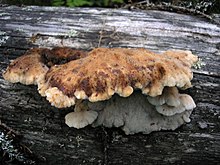Amylocystis lapponica
| Amylocystis lapponica | |
|---|---|

| |
| Scientific classification | |
| Kingdom: | Fungi |
| Division: | |
| Class: | |
| Order: | |
| Family: | |
| Genus: | |
| Species: | A. lapponica
|
| Binomial name | |
| Amylocystis lapponica | |
| Synonyms[1] | |
Amylocystis lapponica (alternatively spelled Amylocystis lapponicus) is a species of
Taxonomy
The fungus was originally described by Swedish mycologist Lars Romell in 1911, who called it Polyporus lapponicus. The type collection was made in Nattavaara (Sweden), where it was found growing on fir. Romell initially thought the fungus might be Climacocystis borealis, but ultimately rejected that opinion, as that species has an easily breakable fruit body, and its spores are of different size and shape.[2]
Amylocystis lapponica has been shuffled to several different polypore genera in its
Description
The fungus has fruit bodies that range in form from crust-like to effused-reflexed (mostly crust-like, with edges curling out to form rudimentary
Amylocystis lapponica has a monomitic hyphal system, containing only generative hyphae. These hyphae are mostly thick-walled and measure 4–10.5 μm thick.[9] The spores are cylindrical, hyaline, and smooth, measuring 8–11 by 2.5–3.5 μm. They are unreactive in Melzer's reagent.[8]
Habitat and distribution
Amylocystis lapponica decomposes fallen
In contrast to its rarity in Central and Southern Europe, A. lapponica is known from hundreds of localities in Finland and Sweden, and dozens in Norway.
In Europe, the fungus has been recorded from 12 countries, and is red-listed in 7 countries. In 2004, Amylocystis lapponica was one of 33 species proposed for
The discomycete Hyaloscypha epiporia grows only on the surface of old polypores fruiting on softwood, and is often found on old, partly decayed fruit bodies of Amylocystis lapponica.[16]
References
- ^ a b "GSD Species Synonymy: Amylocystis lapponica (Romell) Bondartsev & Singer". Species Fungorum. CAB International. Retrieved 2018-01-07.
- ^ Romell, L. (1911). "Hymenomycetes of Lappland". Arkiv før Botanik. 11 (3): 1–35.
- ^ Pilát, A. (1933). "Additamenta ad floram Sibiriae Asiaeque orientalis mycologicam". Bulletin de la Société Mycologique de France. 49: 256–339.
- ^ Kavina, Karel; Pilát, Albert (1938). Atlas des champignons de l'Europe. Polyporaceae II. Vol. 3. Prague. p. 179.
{{cite book}}: CS1 maint: location missing publisher (link) - ^ Lowe, J.L. (1975). "Polyporaceae of North America. The genus Tyromyces". Mycotaxon. 2 (1): 1–82 (see p. 26).
- JSTOR 3754880.
- ^ Lloyd, C.G. (1915). "Synopsis of the section Apus of the genus Polyporus". 7: 319.
{{cite journal}}: Cite journal requires|journal=(help) - ^ ISBN 978-8290724462.
- .
- ^ .
- ^ ISBN 978-92-871-5928-1.
- ^ Bredesen, B.; Haugan, R.; Aanderaa, R.; Lindblad, I.; Økland, B.; Røsok, Ø. (1997). "Wood-inhabiting fungi as indicators on ecological continuity within spruce forests of southeastern Norway". Blyttia. 54: 131–140.
- ^ Røsok, Ø. (1998). "Amylocystis lapponica in Norway, an indicator species for species-rich continuity forests". Blyttia. 56: 154–165.
- ISBN 978-0-7726-7054-0.
- JSTOR 23727192.
- .
